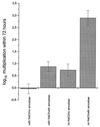Influence of Acanthamoeba castellanii on intracellular growth of different Legionella species in human monocytes
- PMID: 10698751
- PMCID: PMC91922
- DOI: 10.1128/AEM.66.3.914-919.2000
Influence of Acanthamoeba castellanii on intracellular growth of different Legionella species in human monocytes
Abstract
Previous studies using a murine model of coinhalation of Legionella pneumophila and Hartmannella vermiformis have shown a significantly enhanced intrapulmonary growth of L. pneumophila in comparison to inhalation of legionellae alone (J. Brieland, M. McClain, L. Heath, C. Chrisp, G. Huffnagle, M. LeGendre, M. Hurley, J. Fantone, and C. Engleberg, Infect. Immun. 64:2449-2456, 1996). In this study, we introduce an in vitro coculture model of legionellae, Mono Mac 6 cells (MM6) and Acanthamoeba castellanii, using a cell culture chamber system which separates both cell types by a microporous polycarbonate membrane impervious to bacteria, amoebae, and human cells. Whereas L. pneumophila has shown a maximal 4-log-unit multiplication within MM6, which could not be further increased by coculture with Acanthamoeba castellanii, significantly enhanced replication of L. gormanii, L. micdadei, L. steigerwaltii, L. longbeachae, and L. dumoffii was seen after coculture with amoebae. This effect was seen only with uninfected amoebae, not with Legionella-infected amoebae. The supporting effect for intracellular multiplication in MM6 could be reproduced in part by addition of a cell-free coculture supernatant obtained from a coincubation experiment with uninfected A. castellanii and Legionella-infected MM6, suggesting that amoeba-derived effector molecules are involved in this phenomenon. This coculture model allows investigations of molecular and biochemical mechanisms which are responsible for the enhancement of intracellular multiplication of legionellae in monocytic cells after interaction with amoebae.
Figures






References
MeSH terms
LinkOut - more resources
Full Text Sources

